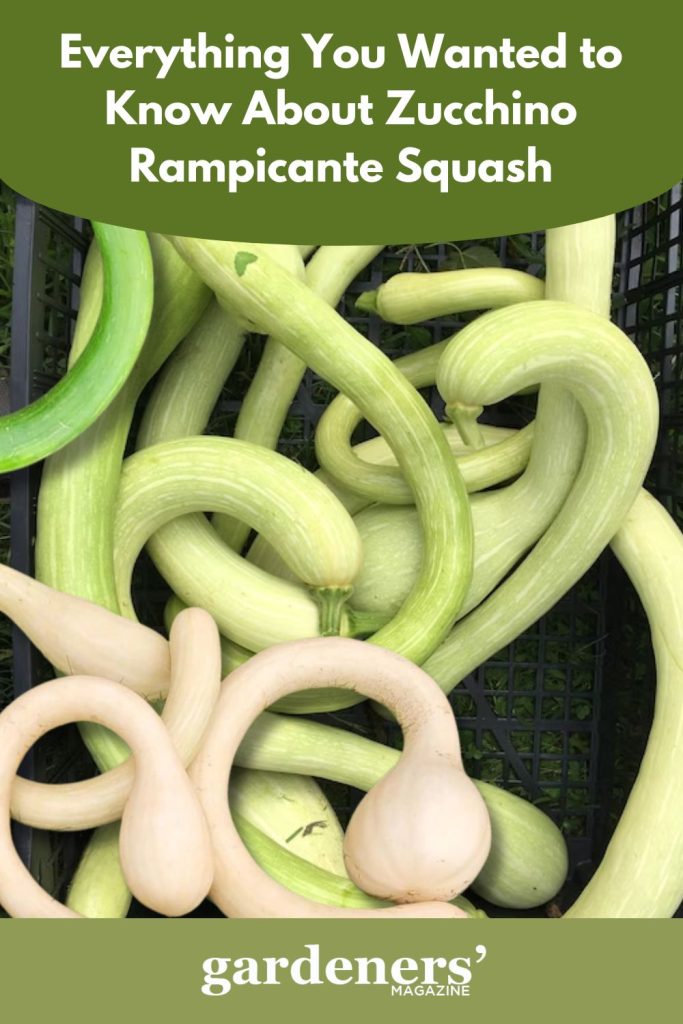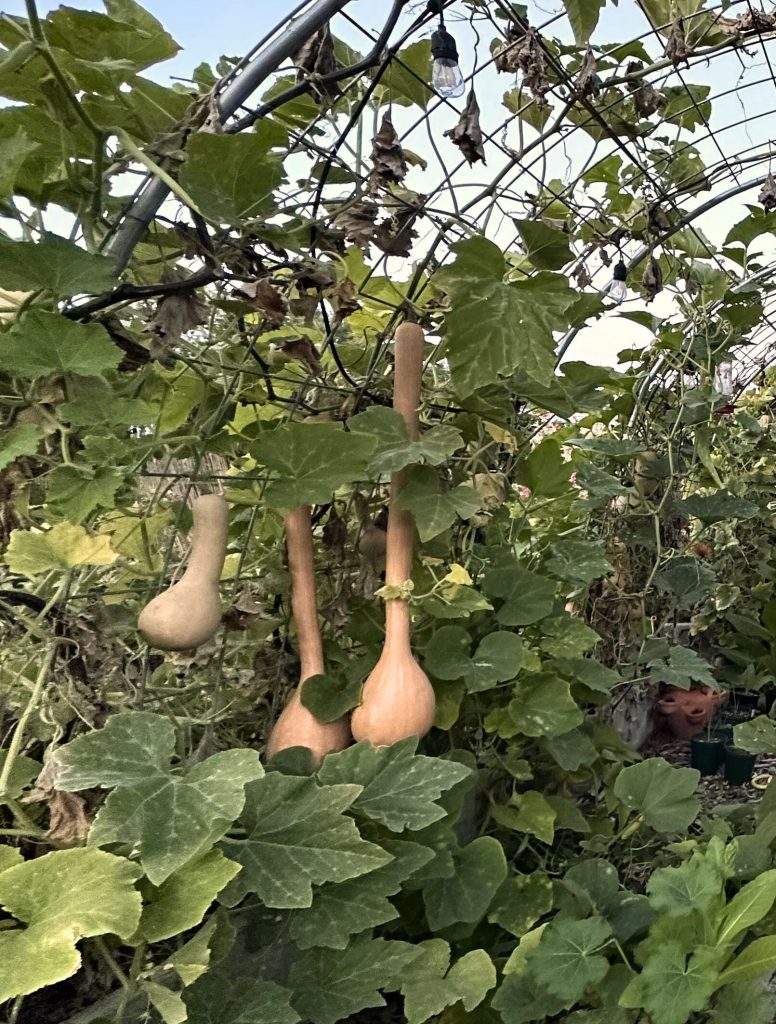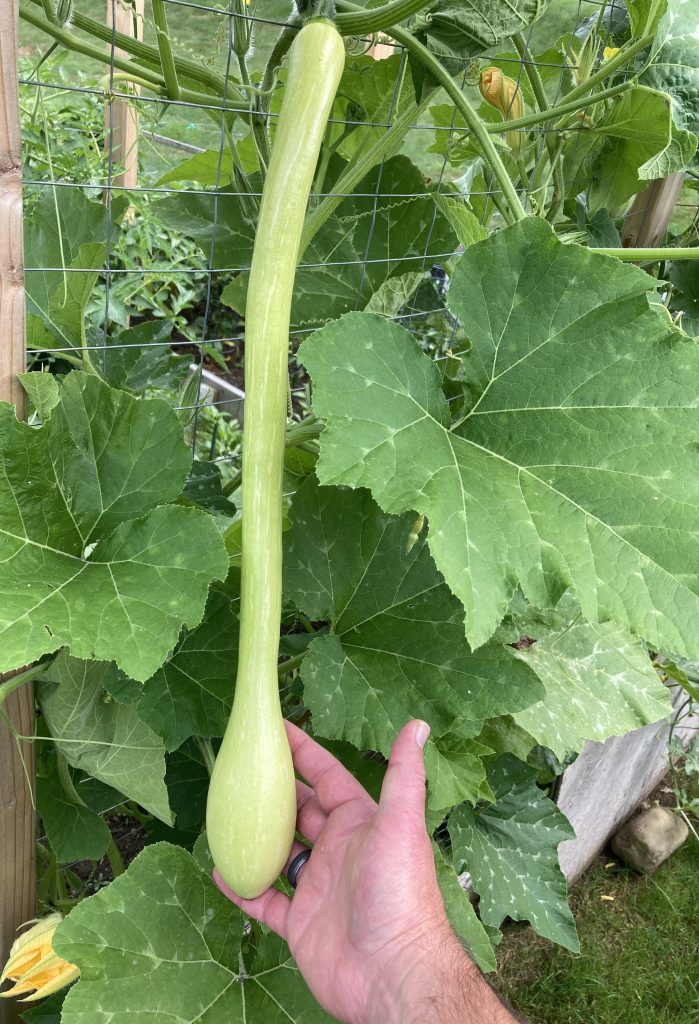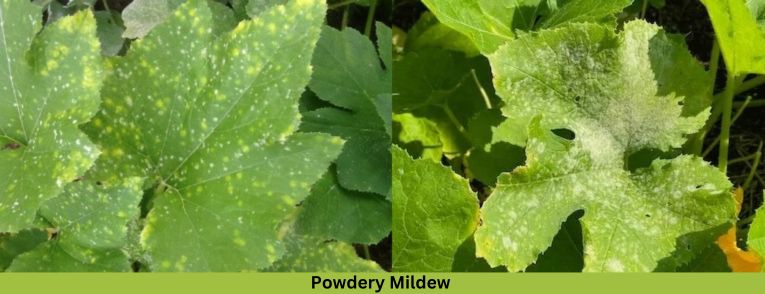Zucchino Rampicante Squash is a unique type of squash that has become increasingly popular in recent years. Its distinctive flavor and health benefits have made it a favorite among chefs, gardeners, and foodies alike.
What sets Zucchino Rampicante apart is its unusual shape and growth habit. This type of squash climbs vigorously, in contrast to conventional squashes that grow along the ground. It’s popular in small-space gardening because it can be trained up fences or trellises. The squash is long and thin, frequently growing to lengths of more than three feet. Its skin has a light green color with white stripes, and the majority of the seeds are concentrated at the bulbous end.
History and Origin of Zucchino Rampicante Squash
It has its roots in the Mediterranean, particularly in Italy and Spain. It’s believed to have been cultivated from wild summer squashes by Italian farmers several centuries ago. Gardeners have been enjoying this heirloom type for years because of its distinctive characteristics. Today, it is popular all over Europe and increasingly so in other parts of the world. Heirloom varieties like this one are crucial for maintaining genetic diversity in our food crops. They connect us to our gardening heritage and the generations of growers before us who valued flavor and variety over commercial yield and uniformity.

Description of Zucchino Rampicante Squash
The most striking feature of Zucchino Rampicante Squash is its elongated shape. The fruits are long and slender, often growing over three feet in length. They have a curved, serpentine appearance, with a narrower neck and a bulbous end where the seeds are concentrated.
The skin of the young squash is a vibrant light green with pale, white vertical stripes. As it matures, the skin turns a tan color and hardens, similar to winter squashes. The skin is dark green with white stripes, and the flesh inside is bright yellow. It has a mild, sweet flavor, and its texture resembles that of spaghetti squash when cooked.

Flavor Profile of Zucchino Rampicante Squash
When harvested young, the Zucchino Rampicante has a mild, subtly sweet flavor. It lacks the sometimes watery or bland taste found in common zucchini. Instead, it offers a slightly nutty and earthy undertone, making it a versatile ingredient in various culinary preparations. As it matures, the flavor deepens and becomes richer, resembling butternut squash more closely. The sweetness intensifies, and it develops a more pronounced nutty and buttery taste.
It can be eaten raw or cooked, and it is often used in soups, salads, stir-fries, and other dishes. Mature fruits, with their firmer texture, are excellent for baking and roasting.
Health Benefits of Zucchino Rampicante Squash
It is rich in vitamins and minerals, such as vitamin A, potassium, magnesium, and calcium. It is also a good source of dietary fiber, which can help promote digestive health and prevent constipation. The presence of antioxidants helps combat oxidative stress in the body, reducing the risk of chronic diseases.
Additionally, it is low in calories but high in complex carbohydrates, making it a great choice for weight loss efforts. The fiber in Zucchino Rampicante can help stabilize blood sugar levels, making it a suitable vegetable for people with diabetes.
Seasonality and Availability Throughout the Year of Zucchino Rampicante Squash
Zucchino Rampicante Squash is generally available from summer to fall. It can be easily found in supermarkets, farmer’s markets, and local grocers during this time of year. If you grow and harvest them at full maturity, they can be stored for use throughout the winter. Mature squashes have a hard skin and can be kept for several months in a cool, dry place, much like other winter squashes.
Cultivation Of The Zucchino Rampicante Squash
- Zucchino Rampicante Squash requires a long growing season and does best in warm climates with plenty of sunlight.
- It should be planted in rich soil that is well-drained and kept consistently moist. The ideal soil pH should be slightly acidic to neutral (pH 6.0 to 7.0).
- When the soil has warmed up and the last frost has passed, usually in late spring, plant the seeds, leaving approximately an inch below the surface.
- To give the seedlings or seeds adequate room to grow, space them 2 to 3 feet apart.
- The vines should be supported with a trellis or other structure to ensure they do not become too heavy.
Harvesting of the Zucchino Rampicante Squash
Zucchino Rampicante Squash should be harvested when the skin begins to turn yellow and before any signs of decay appear. To harvest, use a sharp knife to cut the squash from the vine. It is important to handle it with care as the skin can be easily bruised or damaged. A good test for maturity is to try pressing your fingernail into the squash’s skin. If it resists puncture, it’s likely ready for harvest as a winter squash.

Harvesting Zucchino Rampicante Squash at the right time and with the right technique ensures you get the best flavor and texture from your crop. Enjoy the fruits of your labor in a variety of delicious dishes!
Where Does Zucchino Rampicante Squash Grow? Region-wise.
Zucchino Rampicante Squash is native to Italy and grows best in warm climates such as North Africa and California. It can also be grown in many parts of Europe, especially southern and eastern Europe, where the climate is favorable. The squash is versatile and can adapt to various soil types, provided the soil is well-draining and rich in organic matter.
It can also be grown in other areas with a long growing season if the conditions are right. The growing season can be extended using greenhouses or cold frames.
What are the Things to Remember when Buying Zucchino Rampicante Squash?
When purchasing Zucchino Rampicante Squash, look for firm and unblemished skin. The color should be uniform, and there should not be any signs of decay or mold. The size of the squash will depend on its age, as they can grow up to 30 cm in length. Gently press the squash with your thumb. It should feel firm and not yield too much to pressure. Overly soft squash might be an indication of overripeness or internal damage. Pick up the squash and assess its weight. It should feel heavy for its size, indicating good moisture content and freshness.
How to Store Zucchino Rampicante Squash?
Zucchino Rampicante Squash should be stored at room temperature, away from direct sunlight. It is best to keep them dry and not refrigerate, as this can cause the skin to become soft and make the squash more prone to decay. Before storing, check for any cuts or bruises. Damaged squash should be used first, as they won’t store well. They can also be stored in a cool, dark place for up to a month. Ensure there’s enough space between each squash to allow for proper air circulation.
Common Problems with Zucchino Rampicante Squash
- Powdery Mildew: A common fungal disease called powdery mildew causes white, powdery patches on leaves. Because it grows best in humid environments, it can be mitigated by increasing air circulation and decreasing leaf moisture.
- Squash Vine Borers: These pests burrow into the stems, causing the plant to wilt and die. Look for signs of frass (sawdust-like excrement) at the base of the plant.
- Bacterial Wilt: This disease, which is spread by bacteria that cucumber beetles carry, causes the plant to wilt and eventually die. Plants that are infected should be removed to stop the spread.

How Do You Use Zucchino Rampicante Squash with Other Fruits and Vegetables?
Zucchino Rampicante Squash is very versatile and can be used in a variety of dishes. It pairs well with other vegetables such as tomatoes, onions, bell peppers, and garlic. It can also be cooked with fruits such as apples, pears, and grapes to create a flavorful side dish. The squash can also be roasted, grilled, steamed or sautéed for a delicious meal.
It’s crucial to remember that you should only consume the flesh within and not the skin. Moreover, the seeds can be taken out and roasted to make a delicious snack.
Zucchino Rampicante Squash is a great addition to any healthy diet, as it contains vitamins A, C, and K as well as dietary fiber. It is also low in calories, fat-free, sodium-free, and cholesterol-free, making it an excellent choice for those looking to maintain their health.
Conclusion
Zucchino Rampicante Squash is a unique type of delicious and nutritious squash. It has a variety of uses in the kitchen, from being used as an ingredient for savory dishes to being roasted or grilled as a side dish. Furthermore, it is low in calories and fat-free, making it an excellent choice for those looking to maintain their health. With its unique flavor profile, versatility in the kitchen, and numerous health benefits, Zucchino Rampicante Squash is a great addition to any meal.
Want to learn about a unique squash varieties? Check out our article on candy roaster squash. It’s sweet and great for cooking, and we’ll show you what makes it different from other squashes. You’ll love trying it in your recipes!
- Everything You Wanted to Know About Red Tamarillos - June 2, 2025
- A Guide to Tulips: Everything You Need to Know & More… - June 2, 2025
- Guanabana: Description, Flavor, Benefits, And Uses - May 27, 2025

4 thoughts on “Everything You Wanted To Know About Zucchino Rampicante Squash”
Comments are closed.